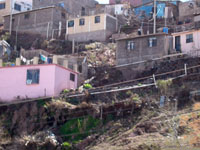
- My Home Page
- My Bio
- Family Object
- Immigrant Agency
- Border Links
- Country Poster
- City Migrants
- Crossing the Valley
- Open Letter
Nogales Trip
While most U.S. citizens have heard of the North American Free Trade Agreement (NAFTA) and know of the poverty in Mexico, they usually can draw no connecting threads from one to the other. However, after visiting the maquiladora Curtis de Mexico and hearing Kiko Trujillo, Borderlinks’ director in Mexico, speak at House of Mercy it’s impossible not to notice the tie in factors. There are obvious items implicating NAFTA has at the very least been contributing to Mexico’s poverty. The article “NAFTA’s Impact on Mexican Agriculture and Rural Life” produced by the Institute for Agriculture and Trade Policy indicated that by 1995 NAFTA had caused the loss of 1 million Mexican jobs (Suppan 14). A fact like this unfortunately seems to stay buried in academic journals where the average American never sees it. Perhaps a comparison would be more eye opening.
Phoenix, Arizona is currently experiencing a population explosion. The Phoenix area has grown from approximately 439,000 in the 1960’s to 1.4 million in 2004 (http://phoenix.gov/BUDGET/bud04pro.pdf). Maricopa County is one of the fastest growing counties in the country and housing communities are spreading across the valley like wildfire to meet these expanding needs. The city is investing in more roads and miles of freeway to attempt to alleviate the bottlenecked streets and contractors are building pink-stuccoed strip malls full of food and goods at the most competitive rates possible. Even with all of the houses, roadways and shopping centers there is still a 3-4 month wait to purchase a new house, traveling across the valley takes at least an hour at peak periods and parking lots are full beyond capacity. It seems as though Phoenix can’t quite handle the influx of people.
Nogales, Sonora seems small, when comparing its population to that of Phoenix. Nogales has felt a similar growth spurt, gaining population from 30,000 in the 1960’s to nearly 300,00 today. In contrast to Phoenix, Nogales has not seen an increase in roadway construction, housing communities built by professional contractors or affordable priced food and clothing. As we saw the homes are constructed with whatever building materials are available, usually on land that has been squatted. The roads that are paved, have been paved with rough concrete and there’s no highway to speak of.
As indicated by the article “We Are Not Machines: Corporations that bring jobs must bring justice too,” the hard-line difference between these two growing cities is the infrastructure (Torres17). In her article, Maria Guadalupe Torres discusses the problems found in the colonias due to the maquiladoras. In Phoenix, though the infrastructure is having difficulty adjusting and adapting to the growth, it’s still there and being increased to meet the demands that are being put on it. In Nogales, the city is only now trying to create an infrastructure, woefully behind the development of the city itself.
Much of the demands placed on Nogales’ growing infrastructure have been placed there by NAFTA and the maquiladora industry that it helps to build and sustain. NAFTA’s policies are such that U.S. companies find it cheaper to move the labor aspect of their companies to Mexico, where the average worker salary is only $8.30 per day and the tariffs on importing the goods back into the U.S. are nearly zero. Nogales being situated so close to the border makes it an ideal city in Mexico to build the maquilas. The presence of the maquilas and their proximity to the border has encouraged thousands of Mexican citizens to migrate north into the city. This massive influx of life has been so overwhelming for the formerly small town that the people have nowhere to go. As Kiko Trujillo of Borderlinks told us, many people upon first arriving in Nogales sleep under a tree for a few days before they can find some land to squat on and build.
The influx of people will only continue so long as NAFTA’s policies continue to encourage the export of labor into Mexico, and therefore Nogales will continue to suffer. There’s no easy solution to this problem, as the infrastructure that Nogales is trying to create has been too long in coming. Maquilas will not pull out of the area back to the U.S., they would only move to a cheaper country if the U.S. or Mexico were to incur fines or some other penalty for the type of slave labor that they encourage. Mexico, and Nogales in particular is caught in a massive globalizing modernization without the resources to become modernized. Until the government of Mexico finds a way to increase its infrastructure and support itself without having to rely on the maquilas for employment the situation will only continue to worsen.
Work Completed by: Stephanie Cleland

